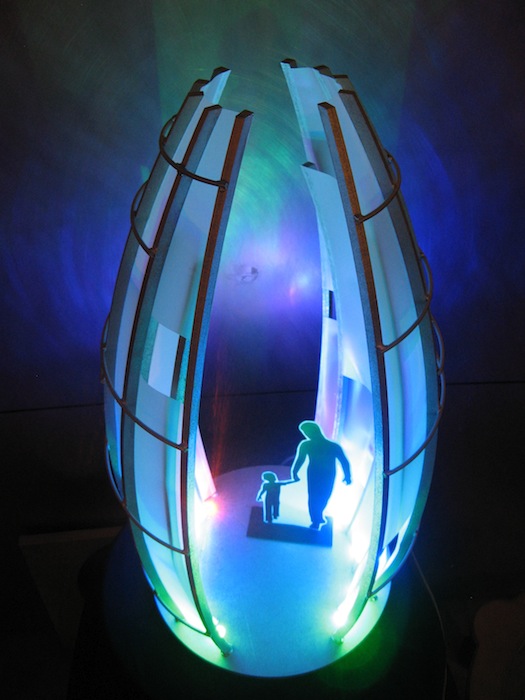I was very intrigued by the guest artist Deborah Aschheim who came to class on Thursday.
I remembered her from a couple of years ago when she had come to WPI to commission an art piece in Fuller Labs. I had never really understood what her work was exactly, so it was interesting to get the chance to talk with her and have her tell us her perspective. The piece was inspired from Deborah’s fascination with memories.
In class, she explained to us about her interest in Cognitive Psychology, and how humans have the ability to create memories from nothing, and that memory is still something that we don’t fully understand. She told us about this “artificial” memory she had had from a photograph of her from when she was little. By remembering the photograph, she made up a memory from when she was IN the photograph—when in fact, she was too young at the time to have remembered it at all.

Deborah beginning her art piece on the stairs of Fuller Labs
That is when Deborah got the idea to make these sculptures, one of which is the same sculpture in Fuller Labs. The piece is composed of different segments, and each main segment has a little display that is playing some sort of video. Some of the parts of the sculpture were connected to video-feeds, as if the walls in Fuller Labs could see and make memories. Other video clips were taken from various places throughout the building, and played on the screens. Some of these videos were direct screen capture that was recorded from a PC in Fuller that someone had been using. Others were scenes from a classroom. The piece gives you many different flavors of what the building that is “Fuller Labs” has to offer.
Just so you can really understand, I’ve included a close-up photo below of how Deborah’s little video “hubs” looked. You can see some of the different video clips that these devices were constantly playing.

A section of the piece in Fuller. Each “hub” has a mini screen inside that each play a different video clip. These are supposed to be “living memories”.
One of the main things I found so interesting about Deborah, is that right away she told us she had a “Nixon obsession”. I wasn’t sure exactly what this meant at first, but she explained that she had grown up in the era of President Richard Nixon. And when she was young, the political turmoil of that time had had quite an effect on her. She was fascinated by the Watergate Scandal, the violent acts against the Ohio students at Kent State, and the event of the only president in American history to ever resign. Deborah shared with us how she would constantly draw scenes from old photographs from these times, as if tracing the images would somehow allow her to eventually make sense of this.
I truly loved this about Deborah. You can get a feel for her innate sense of curiosity; which is crucial in an artist. I could relate to her looking at public figures and wanting to understand who they really are. What do they think like? What was crossing Nixon’s mind when he had to announce his resignation? It’s easy to forget how those who are famous are still people, and honestly, are not all that different from us. Wanting to understand them on a personal level, where you could justify their thoughts and actions, is an interesting, complex, and yet understandable vendetta.
On Deborah’s website she has a section on “Involuntary Memories”, which are about her Nixon fascination. I enjoyed going through these and reading through the different stories and images, so I’ve attached a link to it here.
http://www.deborahaschheim.com/collections/view/346

